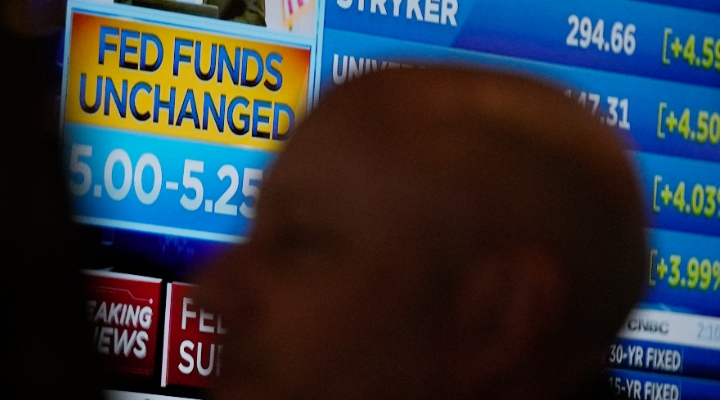
Today, the Bank of Canada announced that it would raise its target for the overnight rate to 5%, with the Bank Rate at 5.25% and the deposit rate at 5%. The Bank is also continuing its policy of quantitative tightening.
The Bank’s July Monetary Policy Report projects the global economy will grow by around 2.8% this year and 2.4% in 2024, followed by 2.7% growth in 2025.
“In light of the accumulation of evidence that excess demand and elevated core inflation are both proving more persistent, and taking into account its revised outlook for economic activity and inflation, Governing Council decided to increase the policy interest rate,” the Bank said in a press release. It added that quantitative tightening is complementing the restrictive stance of monetary policy and normalizing the Bank’s balance sheet.
In explaining its rationale, the Bank said: “Canada’s economy has been stronger than expected, with more momentum in demand. Consumption growth has been surprisingly strong at 5.8% in the first quarter. While the Bank expects consumer spending to slow in response to the cumulative increase in interest rates, recent retail trade and other data suggest more persistent excess demand in the economy. In addition, the housing market has seen some pickup. New construction and real estate listings are lagging demand, which is adding pressure to prices. In the labour market, there are signs of more availability of workers, but conditions remain tight, and wage growth has been around 4-5%. Strong population growth from immigration is adding both demand and supply to the economy: newcomers are helping to ease the shortage of workers while also boosting consumer spending and adding to demand for housing.”
This leaves much for Canadian investors to consider.
"We urge investors to continue to keep a laser-sharp focus on their long-term investment goals, and not short-term market volatility brought forth by interest rate hikes, commodity prices, or general news flow,” says Morningstar Canada’s director of investment research, Ian Tam.
The Bank Continues to Remain Focused on Taming Inflation
“Inflation in Canada eased to 3.4% in May, a substantial and welcome drop from its peak of 8.1% last summer. While CPI inflation has come down largely as expected so far this year, the downward momentum has come more from lower energy prices, and less from easing underlying inflation. With the large price increases of last year out of the annual data, there will be less near-term downward momentum in CPI inflation. Moreover, with three-month rates of core inflation running around 3½-4% since last September, underlying price pressures appear to be more persistent than anticipated,” the Bank said.
The Governing Council remains concerned that progress towards the 2% target could stall, jeopardizing the return to price stability.
As higher interest rates continue to work their way through the economy, the Bank expects economic growth to slow, averaging around 1% through the second half of this year and the first half of next year. This implies real GDP growth of 1.8% in 2023 and 1.2% in 2024. The economy will move into modest excess supply early next year before growth picks up to 2.4% in 2025.
When Will the Fed Start Cutting Rates? Will the Bank of Canada Follow?
In Morningstar’s latest Economic Outlook, Morningstar’s Senior U.S. Economist Preston Caldwell details that although a recession in the next 12 months remains a serious possibility (about 30%), it should be short-lived if it occurs. Once the Fed wins the war against inflation, it will shift to cutting interest rates in order to get the economy moving again.
“First, we expect the Fed to pause its rate hikes after conducting one final hike in July 2023. Then, starting around the beginning of 2024 (we expect in the first meeting in February 2024), we expect the Fed to begin cutting the fed-funds rate,” Caldwell said. Here are his U.S. forecasts:
- Interest-rate forecast: Caldwell projects a year-end 2023 fed-funds rate of 5.25%, falling below 2.00% by mid-2025. That will help drive the 10-year Treasury yield down to 2.5% in 2025 from an average of 3.5% in 2023.
- Inflation forecast: Caldwell projects price pressures to swing from inflationary to deflationary in 2023 and following years, owing greatly to the unwinding of price spikes caused by supply constraints in durables, energy, and other areas. This will make the Fed’s job of curtailing inflation much easier. In fact, he thinks the Fed will overshoot its goal, with inflation averaging 1.8% over 2024-27.
What Should Canadian Investors Do?
Tam reminds investors a core tenet of investing is understanding the amount of risk you can take on.
“Interest rate risk is certainly prevalent today, and will likely continue to cause fluctuations in portfolio value. If these fluctuations are causing you grief, perhaps it's time to revisit your risk profile and time horizon. For investors who are in it for the long haul (like those saving for retirement that's 10+ years away), timing trades around potential interest rate hikes, assuming you get it right, will at best make minimal impact on your long term financial wealth. Staying put is probably the best option here."





:quality(80)/cloudfront-us-east-1.images.arcpublishing.com/morningstar/6ZMXY4RCRNEADPDWYQVTTWALWM.jpg)













